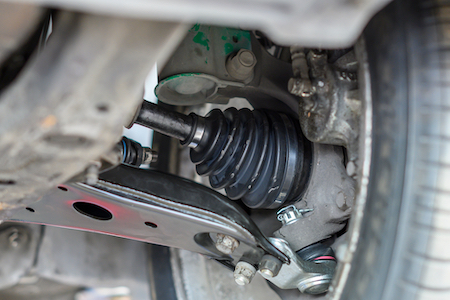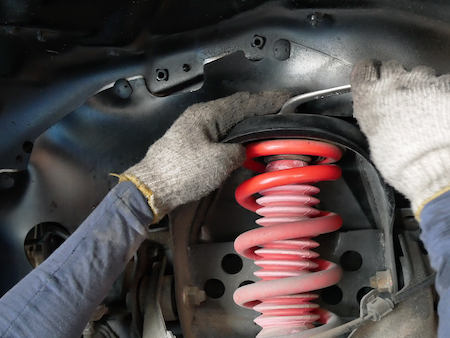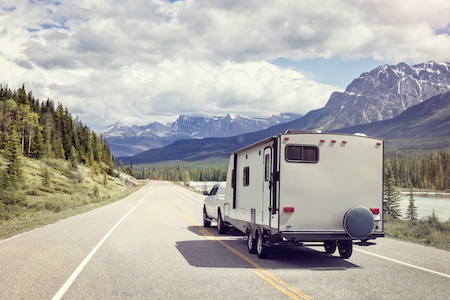“Your tire is flat. You’ll need to replace it.” Those words are straightforward and simple to understand. As a driver, if a mechanic gives you that advice, you may jump right on board.
But some parts are a little more difficult to understand.
“Your CV joint and CV boot are damaged and need repair.” Where do you begin?
What are a CV joint and CV boot?
CV stands for constant velocity. A CV joint (or CV axle) is used in front-wheel drive vehicles to transfer engine power to the drive wheels. It’s also used in some vehicles with independent rear suspension, as well as some four-wheel and all-wheel drive cars.
A CV axle uses two CV joints (an inner and outer joint) to transfer power to the drive wheels at a constant speed no matter what the travel conditions. That means no matter what speed the vehicle is traveling at, or the state of the road, the CV joint handles the power to ensure a safe and comfortable drive.
CV joints use grease for lubrication. To keep this grease pliable and in good working condition, the CV joints are covered with a rubber boot called a CV boot. CV boots are made from durable rubber designed to withstand extreme temperatures and driving conditions. CV boots are designed to last 100,000 miles or more. But because they are often exposed to the elements, they can and will occasionally go bad. Like other parts on a vehicle, it’s a good idea to routinely inspect CV boots to ensure they are in good working condition. If you move beyond 125,000 miles, scheduling routine inspections will ensure they stay operational and don’t leave you stranded.
How CV joints can fail
CV axles rarely fail. CV joints, however, can occasionally fail if something happens to the CV boot. When a CV boot is torn or fails due to age, the grease inside keeping the CV joints well lubricated starts to leak. It also leaves the CV joints unprotected, meaning dirt, grime, and other debris from the roadway can enter the joint. When this happens, it will eventually fail.
Of the two, the outer joint will almost always fail first. That’s because more of the action is performed using this joint, and it’s also more vulnerable to the open road. If you suspect damage to the CV joints, it’s almost always the outer joint.
How CV boots can fail
If the CV boot gives out, it puts the CV joints in danger. Ensuring the CV boot is in good working condition can prevent most costly problems. CV boots can give off several warning signs of a problem:
Grease leak – it’s the most common symptom of a CV boot issue. Over time, the rubber can become dry, brittle, or crack. Once a split occurs in the rubber, grease from the CV joint can leak out. You’ll see this on the inside of the wheel, or flung onto the chassis or other parts of the underside of the vehicle as the CV joint continues to turn.
Clicking, popping, or grinding noise – if a CV boot is damaged for a while, it can lead to a CV joint becoming loose on the axle. If you hear a noise during turns, this might be the case. Most CV joints that reach this stage need replacing.
Vibrations – if a CV boot is damaged, it can allow dirt, grime, and other particles to get underneath the boot and near the CV axle. This debris causes damage, which can lead to a vibration up from the CV axle and through the steering wheel. This may only happen at certain speeds.
A CV boot is a protection device to keep the CV axle and CV joint clean and damage-free. It’s the first line of defense. To ensure a long life, keep an eye on the CV boot for potential damage, and maintain and repair it at the first sign of wear.
Inspecting the CV Axle
Whenever you suspect a problem with your vehicle, the fastest way to ensure everything is working well is to bring it in for an inspection. Trust our knowledge and experience to ensure your car is working well and won’t leave you stranded.
If you do suspect a potential problem with your CV axle, you can do a manual check at home with just a simple flashlight in hand.
First, park your car on level ground. Ensure the emergency brake is engaged.
Next, slide underneath the vehicle at front center, to be able to inspect both CV axles at the same time. Alternatively, you can slide underneath in front of one wheel at a time and inspect them separately.
Look closely at each CV axle. Each axle has two CV boots – outer and inner. Visually inspect the rubber for cracks, leaks, or other damage. If you see grease leaking, it’s a sign of wear.
If you suspect CV joint damage, you can take your vehicle out for a drive, paying attention to the way it drives. On a flat surface, such as an empty parking lot, turn the steering wheel all the way in one direction, then drive in a circle. Repeat going the opposite direction. If one of the CV joints is bad, you’ll notice a clicking or popping sound as you drive in a circle.
If the CV joint is bad enough for you to hear a clicking or popping sound while driving straight, it’s reached the end of life, and will ultimately fail soon. Schedule an appointment as soon as possible to avoid further damage, or risk being stranded by the edge of the road.
Does your vehicle need CV joint or CV boot repair?
CV boots serve as a protection device to allow the CV axles and joints to remain clean and in good working condition. To maintain a long service life, inspecting them at the first sign of potential damage is important. When in doubt, have a professional check it out. Make an appointment today.








 A driver who uses his or her ears has a leg up on those who don’t. Noises, in addition to helping us to be aware of traffic, can also give us clues to potential problems in our vehicles. One noise to pay special attention to is growling.
A driver who uses his or her ears has a leg up on those who don’t. Noises, in addition to helping us to be aware of traffic, can also give us clues to potential problems in our vehicles. One noise to pay special attention to is growling. The rack is linear rather than round. It’s long and flat with prongs on one side. The rack is attached to the steering column by a series of tie rods.
The rack is linear rather than round. It’s long and flat with prongs on one side. The rack is attached to the steering column by a series of tie rods. A coil spring system works by supporting the weight of the vehicle on coil springs and controlling impact by spring weight. The springs are mounted on either the upper or lower control arm, which also determines where the ball joint will be placed. The load-carrying ball joint is always on the same control arm with the spring.
A coil spring system works by supporting the weight of the vehicle on coil springs and controlling impact by spring weight. The springs are mounted on either the upper or lower control arm, which also determines where the ball joint will be placed. The load-carrying ball joint is always on the same control arm with the spring.